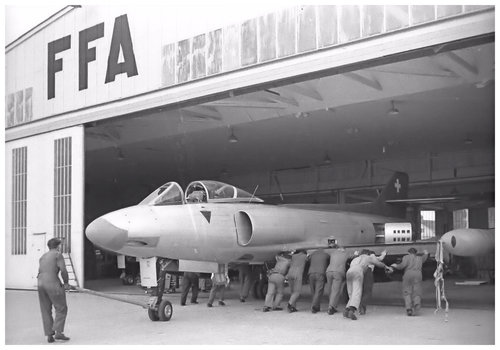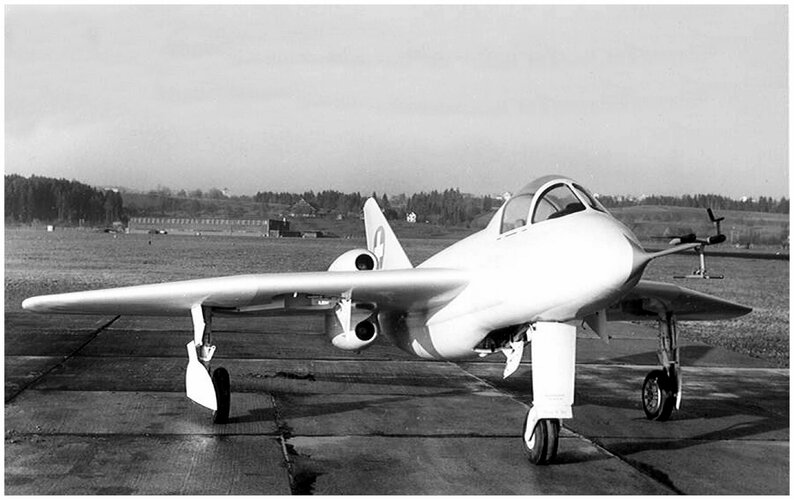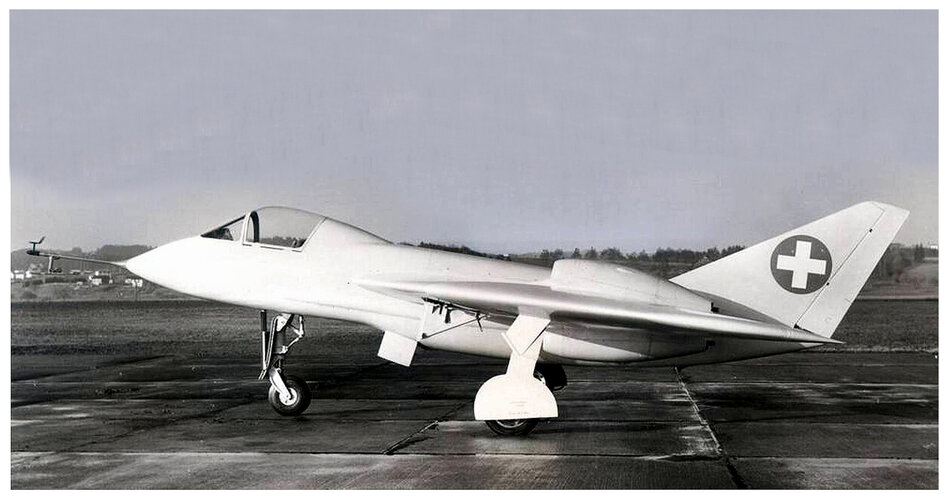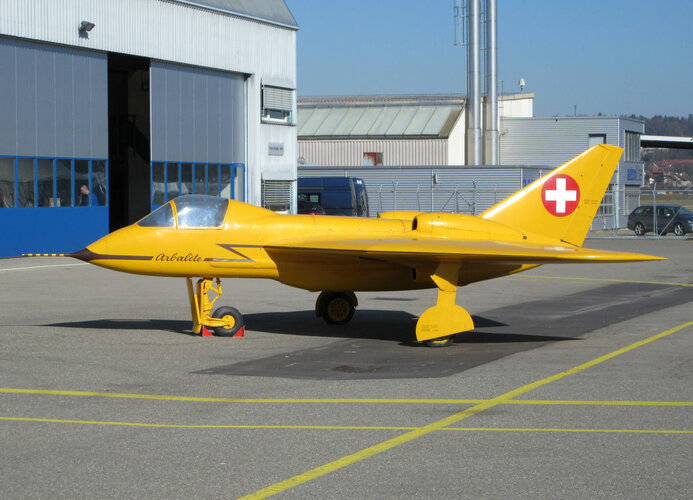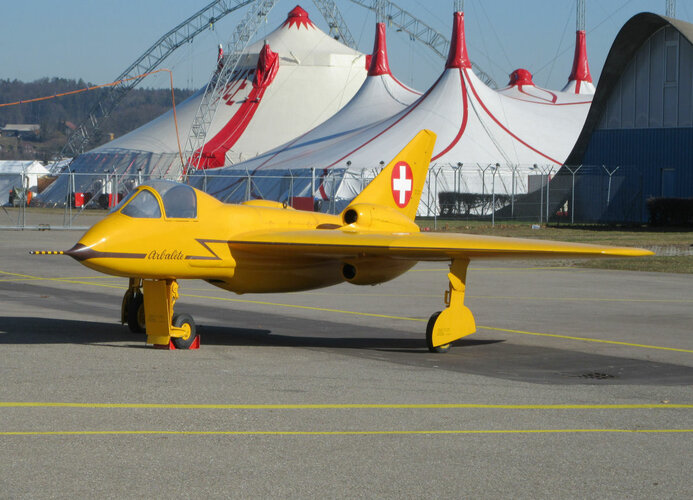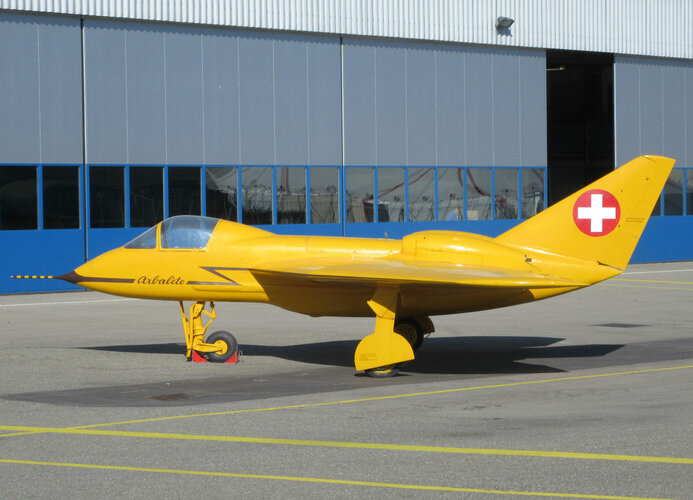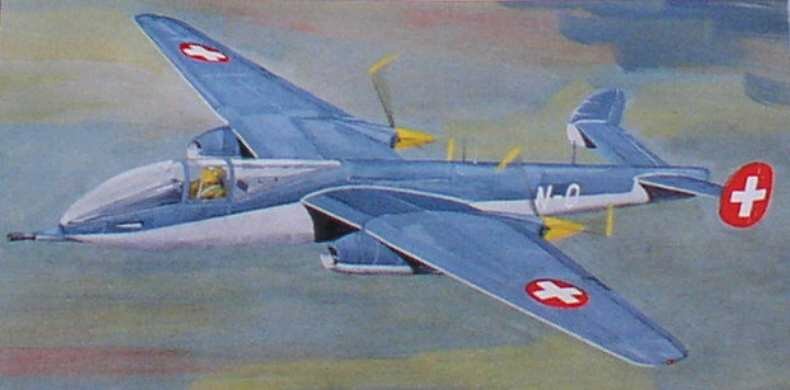You are using an out of date browser. It may not display this or other websites correctly.
You should upgrade or use an alternative browser.
You should upgrade or use an alternative browser.
Postwar fighter projects from Switzerland (Schweiz / Suisse)
- Thread starter Flitzer
- Start date
- Joined
- 26 May 2006
- Messages
- 34,869
- Reaction score
- 15,733
Here is a Model to early P-16 with V-tail;

 swissairforceminiature.blogspot.com
swissairforceminiature.blogspot.com
Musée volant d'Altenrhein
Voici le musée volant d'Altenrhein et les alentours de l'aérodrome. Un joli musée avec quelques raretés, comme les maquettes de souffleries...
Attachments
N-20
ACCESS: Restricted
New on this forum and amazed by the information that comes up here.
My focus of interest is the N-20.2 Arbalète for the simple reason that I am in the process of building that aircraft. Yes, a full scale flying replica that will be, eventually. My collection of data of the N-20.1 and the N-20.2 has grown to a respectful size over the past years but I still run across more pictures and documents. All of which are very useful in respect of the project. So if someone happens to have some sort of information, be it blueprints, reports, pictures or clips of the N-20.2 then please post them here or drop me a note. Anything goes.
And if there are questions about the Arbalète, just ask. I might have the answer.
My focus of interest is the N-20.2 Arbalète for the simple reason that I am in the process of building that aircraft. Yes, a full scale flying replica that will be, eventually. My collection of data of the N-20.1 and the N-20.2 has grown to a respectful size over the past years but I still run across more pictures and documents. All of which are very useful in respect of the project. So if someone happens to have some sort of information, be it blueprints, reports, pictures or clips of the N-20.2 then please post them here or drop me a note. Anything goes.
And if there are questions about the Arbalète, just ask. I might have the answer.
Attachments
- Joined
- 26 May 2006
- Messages
- 34,869
- Reaction score
- 15,733
New on this forum and amazed by the information that comes up here.
My focus of interest is the N-20.2 Arbalète for the simple reason that I am in the process of building that aircraft. Yes, a full scale flying replica that will be, eventually. My collection of data of the N-20.1 and the N-20.2 has grown to a respectful size over the past years but I still run across more pictures and documents. All of which are very useful in respect of the project. So if someone happens to have some sort of information, be it blueprints, reports, pictures or clips of the N-20.2 then please post them here or drop me a note. Anything goes.
And if there are questions about the Arbalète, just ask. I might have the answer.
Welcome aboard N-20,
do you know the earlier series before N-20,we know only N-10 & N-11,
also a small Info about N-0 ?.
N-20
ACCESS: Restricted
Thanks for the replies and the pictures. I have the black and whites in my collection already, amongst other. The coloured ones at DUB however are very nice indeed, although the depleted nose gear damper makes it look a bit sad. Unfortunately I missed the date when the bird was airlifted from Luzern to Dübendorf. Otherwise it would have been a perfect chance to get some close views of the inside as well. Which is of extremely high interest to me because the builders not always kept to the blueprints.
Regarding earlier projects. When going through the archives I stumbled across heaps of data on the N-20. I didn't dig into it too deeply since my focus is on the N-20.2. But amongst all these documents there were also countless drawings and of earlier projects too which I can't recall all of them. So if you want to know more, get yourself access to the archive at Dübendorf and dig in. There's a ton of stuff.
I haven't heard about the N-0. According the drawing it must have been a rather early design. The engines have the shape of Jumos or BMW's and it's a straight wing. The later combined with the prop propulsion gives away the speed advantage of the jet engine. Besides I wonder where they fold in that exceptional high landing gear which is required to get sufficient ground clearance for the props. Looks pretty but not very promising.
Regarding earlier projects. When going through the archives I stumbled across heaps of data on the N-20. I didn't dig into it too deeply since my focus is on the N-20.2. But amongst all these documents there were also countless drawings and of earlier projects too which I can't recall all of them. So if you want to know more, get yourself access to the archive at Dübendorf and dig in. There's a ton of stuff.
I haven't heard about the N-0. According the drawing it must have been a rather early design. The engines have the shape of Jumos or BMW's and it's a straight wing. The later combined with the prop propulsion gives away the speed advantage of the jet engine. Besides I wonder where they fold in that exceptional high landing gear which is required to get sufficient ground clearance for the props. Looks pretty but not very promising.
N-20
ACCESS: Restricted
Air Force Museum Dübendorf, Switzerland.
Getting access the archive took me a while. Working through pallettes of documents takes hours if not days and requires repeated visits. Getting documents copied out of it was another story. Depends who you are talking to there. But it was worth the effort in my case.
Getting access the archive took me a while. Working through pallettes of documents takes hours if not days and requires repeated visits. Getting documents copied out of it was another story. Depends who you are talking to there. But it was worth the effort in my case.
N-20
ACCESS: Restricted
If I had to make the decision today then it would be the PBS TJ100. They produce just about the thrust like the former Piméné. The final choice is not made however. I expect other engines in that thrust category to surface since there's a constant evolution going in that sector. There are numerous drone engines which might become a choice eventually. The difficulty is that they are not available to the open market.
The performance will be identical to the original, if not better. I aim to bring down the all up weight by some 400kg. That should give the performance a bit of an improvement.
The performance will be identical to the original, if not better. I aim to bring down the all up weight by some 400kg. That should give the performance a bit of an improvement.
N-20
ACCESS: Restricted
Reliability is an issue of course. And the PBS proved well in the Sonex aircraft so far. But with four engines on the Arbalète I will hardly notice if one packs up ;-)).
Another issue with drone engines is that many of them have "Verlustölschmierung". The english term doesn't come to my mind right now. The lubrication system runs on a given amount of oil which is spent instead of recovered and reused. Clearly not a recommended system on an aircraft that is intended not to end up in a smoking hole.
Meanwhile PBS came up with a 1100ls thrust version. But as for now it is not meant for use in the civil aircraft circus. Waiting for this to change.
Another issue with drone engines is that many of them have "Verlustölschmierung". The english term doesn't come to my mind right now. The lubrication system runs on a given amount of oil which is spent instead of recovered and reused. Clearly not a recommended system on an aircraft that is intended not to end up in a smoking hole.
Meanwhile PBS came up with a 1100ls thrust version. But as for now it is not meant for use in the civil aircraft circus. Waiting for this to change.
- Joined
- 11 March 2012
- Messages
- 3,247
- Reaction score
- 3,176
That sounds like the "total loss" lubrication system on early motorcycle engines. Trev Dealy's Motorcycle Museum is only a few blocks from my work. They have a fascinating collection of motorcycles spanning more than a century. Many of the early motorcycles had no engine sumps or oil pans or scavenge pumps, so after lubricating gears, the oil just fell on the road.
N-20
ACCESS: Restricted
Another issue that supports the use of a modern engine instead the Piméné ist the start up procedure. It required pressurised air to spin up the turbine, then came the initial run up on gasoline fuel until idle RPM was stable before switching to Kerosene fuel. The valve is situated in the rear of the front wheel bay. Fortunately all this hassle can be avoided today. Modern engines start by the push of a button, set the throttle to idle and wait for the FADEC to tell you that you are ready to go.

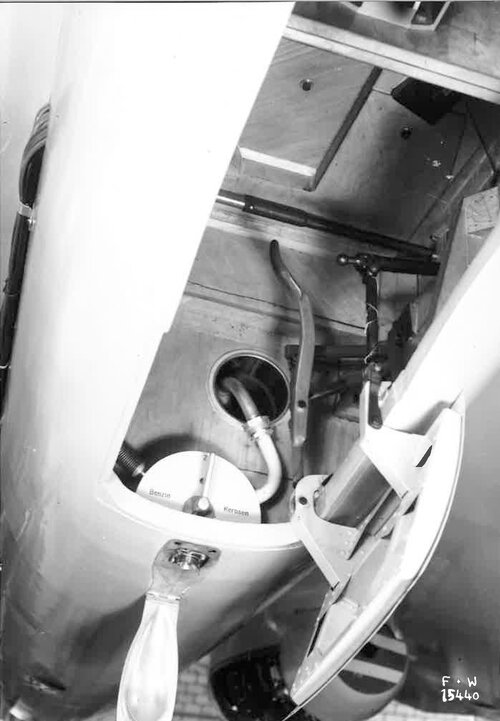
Last edited:
- Joined
- 8 January 2006
- Messages
- 1,610
- Reaction score
- 758
William P. Lear purchased the rights. The company that became Learjet started, IIRC, as Swiss American Aviation Company. The wing and tail surfaces were definitely used on the Model 23 Learjet. If I was trying to model a P-16, I'd start with a Learjet kit for the wings and tail surfaces, preferably a Model 23 or 24 kit but a Model 35/36 kit could have the wings cut back to the original span.The FFA company was a private company, not a government one. So the swiss government had nothing to do with the Lear-Deal.Frequently, FFA-16 has been mentioned, as starting point in development of Learjet twin-engined business jet.
For eample Wikipedia article.
I wonder, how American industrialist Lear obtained rights (or possibility) to use FFA-16 parts for commercial aircraft? Or why Switzerland' government didn't involved in his company? Now we knew Pilatus as sole and successfull Swiss-based aircraft manufacturer. Perhaps, two compnies have been too much for small country?
cheers Andy
- Joined
- 26 May 2006
- Messages
- 34,869
- Reaction score
- 15,733
Hi N-20,
I will make a deal with you,if you can get all Projects from Air Force Museum Dübendorf,and display them here,and take your time,I am not harry,I will send to you a 15 books you don't have,and all of them in PDF form,means E-books,I have more than 1500 books about Aviation,you can pick up what you want from them,and I will use Googledrive,and just I will tell you the links for all those 15
and you can download them easy,I hope you to say; Deal ?.
I will make a deal with you,if you can get all Projects from Air Force Museum Dübendorf,and display them here,and take your time,I am not harry,I will send to you a 15 books you don't have,and all of them in PDF form,means E-books,I have more than 1500 books about Aviation,you can pick up what you want from them,and I will use Googledrive,and just I will tell you the links for all those 15
and you can download them easy,I hope you to say; Deal ?.
N-20
ACCESS: Restricted
All the projects stored at Dübendorf? I wish I had the time. But that would be a lifetime project. It took me days to search through the N-20 documents, besides that it cost me a fortune to have them scanned. And that‘s for the N-20.2 only.
Sorry, can't do.
Here's one of the blueprints of the N-20 engine inlet geometry as an example.
Sorry, can't do.
Here's one of the blueprints of the N-20 engine inlet geometry as an example.
Attachments
Last edited:
- Joined
- 11 March 2012
- Messages
- 3,247
- Reaction score
- 3,176
Wasn't the basic design of the Learjet based on a Swiss Fighter design?
Yes John,
See post #140.
- Joined
- 28 January 2008
- Messages
- 635
- Reaction score
- 511
JohnR said:
Wasn't the basic design of the Learjet based on a Swiss Fighter design?
The P-16 Mk III origins shown in this model of the SAAC-23, particularly the wing layout. The book also had a photo of the P-16 and the SAAC-23 together on the apron at Altenrheim.
Source:
Schweizerische Strahlflugzeuge und Strahltriebwerke by Georges Bridel (Schweizerisches Verkehrsmuseum 1975) ISBN 3859549022
Attachments
- Joined
- 3 September 2006
- Messages
- 1,474
- Reaction score
- 1,468
Wikimedia has this photo:

 de.wikipedia.org
de.wikipedia.org

SAAC-23 – Wikipedia
- Joined
- 8 January 2006
- Messages
- 1,610
- Reaction score
- 758
Yeah, the more motors the more controls and plumbing for them and that can get complicated.SM-01 is configured with 6 engines .I used to be told that the more motors used, the more complicated it is to maintain?
I've attached a set of drawings of the P.16 that I did a few years ago.
I've always be puzzled by the retractable rocket pack. The 80-mm SURA rocket was carried under the wings for anti-tank use and it had a pair of 30-mm HS.825 cannon. here were plenty of hard points for rocket pods, if the 68-mm SNEB was felt necessary. So why add the weight, complexity, and drag of a retractable launcher restricted to the smaller caliber rockets? I'd have thought that the space and weight could have been used better for some combination of armor, extra fuel, and/or extra gun ammunition.
I've always be puzzled by the retractable rocket pack. The 80-mm SURA rocket was carried under the wings for anti-tank use and it had a pair of 30-mm HS.825 cannon. here were plenty of hard points for rocket pods, if the 68-mm SNEB was felt necessary. So why add the weight, complexity, and drag of a retractable launcher restricted to the smaller caliber rockets? I'd have thought that the space and weight could have been used better for some combination of armor, extra fuel, and/or extra gun ammunition.
Attachments
- Joined
- 11 March 2012
- Messages
- 3,247
- Reaction score
- 3,176
Dear Iverson,
The AVRO Canada CF-100 Canuck was designed with a retractable rocket pack under the fuselage. The primary mission was long-range interception of Soviet bombers attacking over the North Pole.
The AVRO Canada CF-100 Canuck was designed with a retractable rocket pack under the fuselage. The primary mission was long-range interception of Soviet bombers attacking over the North Pole.
Last edited:
Yes, as did the Vautour IIN. That is what puzzles me. The P.16 was not an interceptor. It lacked radar and had no realistic need for a weapon designed for single-pass kills of nuclear-armed heavy bombers at stratospheric altitudes. From what I've read, the P.16 was primarily intended as a STOL fighter bomber for close support. For a secondary air-to-air role, the cannon ought to have sufficed--as cannon indeed did when Switzerland bought Hunters instead.Dear Iverson,
The AVRO Canada CF-100 Canuck was designed with a retractable rocket pack under the fuselage. The primary mission was long-range interception of Soviet bombers attacking over the North Pol.
- Joined
- 11 March 2012
- Messages
- 3,247
- Reaction score
- 3,176
kaiserbill said:Fascinating.
As a light fighter concept, it is almost like the forefather of the ALR Piranha by a few decades.
Here some pictures and a 3 side view of the Piranha:
( see http://www.secretprojects.co.uk/forum/index.php/topic,1279.0.html )
ALR Piranha was only one of a series of light-weight fighters proposed during the 1980s. Israeli Lavi, Swedish Grippen, Swiss PIranha, South African Carver Mark 1 and Yugoslav Novi Avion. They were all single-seat, single-engined canard deltas. Their 14,000 kg to 16,000 kg MTOW placed them between the American F-5 Freedom Fighter and the (initially light-weight) F-16.
Only SAAB's Grippen made it into production, which was probably for the best because of the small size of the market. Now Grippen is selling well to second and third world air forces that cannot afford "teenaged fighters" (F-14, F-15, F-16, F-18).
I think you will find the Gripen's attraction is not purely on price. I also think you mind find some challenges with your assertion that it is only second and third world countries purchasing it (Sweden, UK...?). I think in many respects the Gripen is what the F-20 hoped to be - a new F-5. The problem being that the world has moved on from the 60's/70's when the F-5 (and the MiG-21) ruled supreme with sales all over the place.
- Joined
- 25 January 2020
- Messages
- 1,279
- Reaction score
- 1,948
Would the Swiss consider Boeing's tentative T-7 based fighter? That aircraft is also aiming to be the next F-5.
First_philou
Light jet supporter
Another issue that supports the use of a modern engine instead the Piméné ist the start up procedure. It required pressurised air to spin up the turbine, then came the initial run up on gasoline fuel until idle RPM was stable before switching to Kerosene fuel. The valve is situated in the rear of the front wheel bay. Fortunately all this hassle can be avoided today. Modern engines start by the push of a button, set the throttle to idle and wait for the FADEC to tell you that you are ready to go.
View attachment 644681
Another issue that supports the use of a modern engine instead the Piméné ist the start up procedure. It required pressurised air to spin up the turbine, then came the initial run up on gasoline fuel until idle RPM was stable before switching to Kerosene fuel. The valve is situated in the rear of the front wheel bay. Fortunately all this hassle can be avoided today. Modern engines start by the push of a button, set the throttle to idle and wait for the FADEC to tell you that you are ready to go.
View attachment 644681
My following comments are not intended to advise you on the choice of a turbojet for your project, but to come back to the Pimene:
1) Pimene was produced in less than 40 units. It should be impossible to find 4 in the world (and what about the problems related to their restoration, ..). We must therefore switch to another engine.
2) The procedure for starting Pimene with pressurized air does not apply to all Pimene. The Pimene equipping the Sylphe III were equipped with an electric starter
3) Indeed the Pimene have never (to my knowledge) been equipped with the injection system allowing to start directly on Kerosene (unlike the last version of the Palas)
4) We cannot compare directly a Pimene with a TJ100, limited to thrust.
Attached file : Sylphe III with Pimene using an electric starter
Attachments
- Joined
- 9 October 2009
- Messages
- 21,944
- Reaction score
- 13,576
The current Swiss government is very heavily influenced by Brussels, so that is unlikely, even before you take into account increasing concerns about the Biden administration's policy towards arms exports.Would the Swiss consider Boeing's tentative T-7 based fighter? That aircraft is also aiming to be the next F-5.
- Joined
- 27 March 2006
- Messages
- 1,870
- Reaction score
- 1,617
ALR Piranha was only one of a series of light-weight fighters proposed during the 1980s. Israeli Lavi, Swedish Grippen, Swiss PIranha, South African Carver Mark 1 and Yugoslav Novi Avion. They were all single-seat, single-engined canard deltas.
Apart from pics of an early model which was sent to me(which I can no longer find
Similar threads
-
Swiss Fighter Jets: N-20, P-16, Mirage 3S
- Started by Kuno
- Replies: 2
-
-
-

